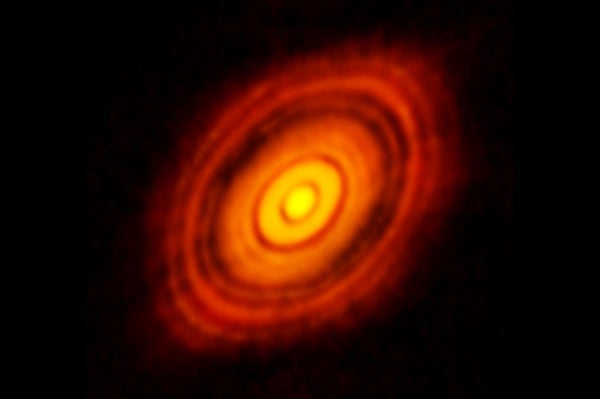A disk of gas and dust around a star some 450 light-years from Earth had astronomers puzzled. When observations of the star HL Tauri revealed a glowing disk split by crisp bands, some assumed unseen planets were carving out paths as they orbited. But new simulations suggest a more complex picture. Those gaps may actually result from gravitational tugs of planets elsewhere in the disk, even outside of the disk, and learning to read these patterns could speed the detection of currently hard-to-find planets.
“We’re going to start seeing more of these coming out very soon, a lot of these beautiful, high signal-to-noise ratio disks that we can see with these structures,” says Maryam Tabeshian, developer of the model and researcher at Western University in Ontario.
Astronomers love such planet-forming, or protoplanetary, disks as well as their less gaseous cousins, debris disks, for the same reason paparazzi love a crowd: a quick glance can usually tell you where your target is. But rather than fame, Tabeshian proposes relying on orbital jostling motions to aid the search.
On supporting science journalism
If you're enjoying this article, consider supporting our award-winning journalism by subscribing. By purchasing a subscription you are helping to ensure the future of impactful stories about the discoveries and ideas shaping our world today.
These dust-and-gas disks may look solid, but they are composed of grains, boulders and mini planets all orbiting at different speeds—faster up close to the star and slower farther out. When a planet syncs up with a distant particle orbiting, say, two times slower or three times faster, it is known as “mean motion resonance.” Each time the planet aligns with a particle, it gives it a gravitational nudge, which can ultimately eject it from the disk entirely.
When this process is spread out along an entire ring, it can open holes far from the planet responsible. Features such as the width, location and shape of the gap could be used to predict the planet’s mass and orbit, according to a pair of papers, the latest of which was published in September by The Astrophysical Journal. For example, a planet orbiting beyond a disk’s radius would produce two rotating arc-shaped holes whereas one orbiting in its interior would create only one, Tabeshian says. An extra gap of a certain type would suggest a planet with a more oblong orbit, and wider gaps point to the presence of more massive planets.
Tabeshian has already put the theory into practice. A study currently under review, prepared with Western University astronomer Paul Wiegert, shows that via resonances, three properly placed exoplanets could produce five of HL Tauri’s gaps. Educated guesses like these could narrow the haystack that exoplanet hunters have to search or, in the case of exterior planets, hint that certain needles lie outside the haystack entirely. “It’s great that theorists like Maryam and Paul are preparing these tools,” says astronomer Erika Nesvold of the Carnegie Institution of Washington, “so then when observers do take interesting pictures, they can get an idea of what they’re looking at.”
But the dusty signs Tabeshian’s simulation predicts may prove hard to read. The view of these disks from Earth has to be just right: top-down, not edge-on. What’s more, the patterns sit right on the technological edge of what current tools can resolve. “The trick is to figure out whether you can do it with either our current telescopes or the next generation of telescopes,” notes Nesvold, who was not involved in the research.
Nesvold is no stranger to the challenges of applying theory to reality: She developed her own model that simulates the chain reaction of collisions a planet sets off when it careens through a debris cloud. Still, she sees these disk techniques as natural complements to well-established planet-detection methods.
Looking for planets based on stars that wobble or flicker tends to reveal big exoplanets with tight orbits—more like Mercury than Earth—but debris disks register disturbances from bodies both near and far. More distant planets would actually be easier to detect, Nesvold says, because the star’s light washes out inner-disk regions. Then, if disk behavior hints at outlying bodies, astronomers will have a better idea where to aim telescopes for the money shot—imaging them directly. This detection method also favors planets orbiting distantly from their stars.
As they refine their techniques, however, direct imagers will strive to find planets closer to their bright host stars, and those who search for wobbles and flickers will push outward toward wider orbits. No method has found an exact Earth twin yet, but Nesvold suggests debris disk models can help the two methods meet in the middle. “To get to Earth orbit,” she says, “we’re kind of coming at it from both ends.”
